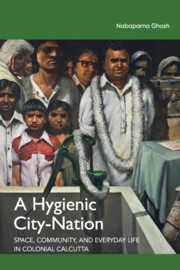Book contents
- Frontmatter
- Contents
- List of Figures, Tables, and Boxes
- List of Abbreviations
- Acknowledgements
- Introduction
- 1 The Black Town, Spaces of Pathology, and a Hindu Discourse of Citizenship
- 2 The Calcutta Improvement Trust: Racialized Hygiene, Expropriation, and Resistance by Religion
- 3 A City-Nation: Paras, Hygiene, and Swaraj
- 4 A New Black Town: Recolonizing Calcutta’s Bustees
- Epilogue
- Glossary
- Bibliography
- Index
4 - A New Black Town: Recolonizing Calcutta’s Bustees
Published online by Cambridge University Press: 26 June 2020
- Frontmatter
- Contents
- List of Figures, Tables, and Boxes
- List of Abbreviations
- Acknowledgements
- Introduction
- 1 The Black Town, Spaces of Pathology, and a Hindu Discourse of Citizenship
- 2 The Calcutta Improvement Trust: Racialized Hygiene, Expropriation, and Resistance by Religion
- 3 A City-Nation: Paras, Hygiene, and Swaraj
- 4 A New Black Town: Recolonizing Calcutta’s Bustees
- Epilogue
- Glossary
- Bibliography
- Index
Summary
Swarajist efforts to transform paras into units of a Hindu-Bengalicity-nation coincided with a steady influx of villagers to Calcutta. Groupsof villagers first started to move to the city when famines forced them toflee their villages in the late nineteenth century. Between 1850 and 1899,twenty-four major famines had destroyed crops and wrecked villages in India.With the constant scarcity of food and loss of crops, the villagers fled tothe cities to find new employment. The Swadeshi economic boycott in 1904speeded up their movement. Swadeshi activists had called for a boycott onall products manufactured in Britain. They appealed to Indians to set upfactories, arguing that only a strong economy could support their fightagainst colonialism. Inspired by Swadeshi ideals of economicself-sufficiency, nationalists like Dr Rashbehari Ghose and Dr NilratanSircar opened soap and match factories in Calcutta. Migrant villagers foundemployment at these factories. They became workers and earned wages thatsustained their lives in the city. The Swadeshi factories attractedvillagers not simply from Bengal but from the entire country. In the soapfactory, for instance, the workers were from Punjab; in the match factories,they came from Bihar.
The arrival of large numbers of villagers resulted in a housing crisis inCalcutta. Neither the state nor factory owners had the wherewithal to housedestitute villagers. When the villagers did not receive any support from thestate, they started erecting makeshift settlements where they found emptyplots of land. These settlements, known as bustees,materialized along busy thoroughfares, railway tracks, and municipal wastedumps, and extended as far as the outer rims of middle-class Hindu paras.The inhabitants of the bustee spoke little or no Bengali. Their diverselanguage, religion, and caste practices informed their neighbourhoods,distinguishing them markedly from the adjoining Hindu-Bengali paras.
In this chapter, I argue that bhadraloks reacted to the sense of threat theyfelt from the arrival of waves of non-Bengali, non-Hindu, and lower-castebustee dwellers by looking inward. Emulating the British, they describedbustees as inscrutable and engaged in a discursive production of bustees asspaces of filth and disease.
- Type
- Chapter
- Information
- A Hygienic City-NationSpace, Community, and Everyday Life in Colonial Calcutta, pp. 154 - 189Publisher: Cambridge University PressPrint publication year: 2020



